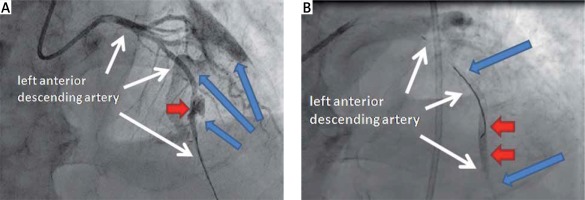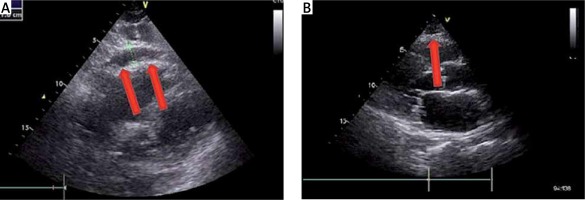Long term oral anticoagulation is used in various conditions such as atrial fibrillation, mechanical heart valves, and venous thromboembolism in approximately 6–8% of patients undergoing percutaneous (PCI) interventions [1]. Coronary artery perforation may occur with an incidence of 0.48% [2]. The risk of complications during coronary angiography increases with patient age, sex, renal impairment, and urgency of the procedure [2]. The first line treatment in cardiac tamponade is pericardiocentesis with drainage. Additional use of idarucizumab to reverse dabigatran might be necessary in such cases to maintain hemostasis in the perforated coronary artery and improve patient recovery. The antidote for dabigatran does not bind known thrombin substrates and has no activity in coagulation tests or platelet aggregation [3]. The analysis of 503 patients from the RE-VERSE AD (Reversal Effects of Idarucizumab on Active Dabigatran) trial found that idarucizumab rapidly normalized hemostasis and reduced levels of circulating dabigatran in subjects on dabigatran who had serious bleeding or required an urgent procedure [4]. Heparin reversal with protamine can be associated with increased risk of device (guiding catheter, guide wire, covered stent) immediate thrombosis.
Figure 1
Angiography. A – Blood extravasation to the pericardium after angioplasty on dabigatran (wide arrow indicates perforating zone, narrow arrows indicate contrast extravasation). B – Control contrast injection after idarucizumab use, pericardiocentesis with drainage and covered stent placement (wide arrows). No blood extravasation is seen (narrow arrows)

Figure 2
Transthoracic echocardiography. A – Subcostal view, fluid accumulation in pericardium after extravasation. B – Parasternal long axis view, assessment after the procedure, less than 5 mm of fluid in pericardium is seen

The lesson to be learnt based on the presented case is that idarucizumab might help in the treatment of major bleeding complications which may occur during interventional STEMI treatment in patients on dabigatran. The antidote should be easily accessible in every catheterization laboratory for emergency use due to the increasing number of patients who will receive dabigatran and more complicated procedures which interventional cardiologists are faced with.








